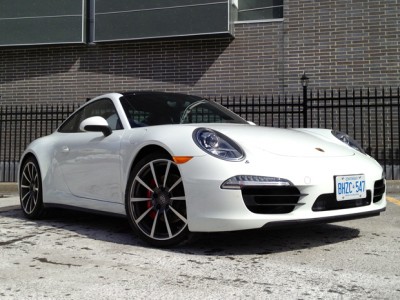Road Test: 2013 Porsche 911 Carrera 4S
Story by John LeBlanc
After surviving yet another winter of Canadian driving, you’re probably saying, “Phew! Thank God I had my all-wheel-drive car!” Now imagine if you could edit out the word “car” with “Porsche,” as in this 2013 911 Carrera 4S.
While its iconic two-door, tear-drop shape and rear-mounted six-cylinder engine formula has remained intact through its half-century of existence, we’ve seen hardtop, convertible, half-roof Targa, no-roof Speedster, wide-body Turbo and various bespoilered race track-ready 911 body styles in that time. And since the 1990s, the one feature some Canadian 911 fans can’t live without: all-wheel-drive.
In fact, worldwide, Porsche says about one in three 911s sold has traction at all four wheels. The popularity of all-wheel-drive speaks to the legend that older, rear-drive 911s liked to swap there ends — i.e. arse-puckering oversteer when lifting off the throttle mid-corner. And although a non-AWD Porsche 911 and a good set of snow tires would suffice for most urban drivers, the perceived “safety” of AWD (generated by the proliferation of SUVs), means your mom would be happier if you were driving an AWD 911, too.
On top of the base, rear-wheel-drive $98,215 911 Carrera hardtop coupe (all prices include transport and pre-delivery inspection), traction at all four wheels adds $7,700. Opt for the more powerful (400 horsepower versus 350) S version, and the 2013 911 Carrera 4S starts at $121,585. My tester came with a seven-speed manual gearbox, but most 911 buyers opt for the $4,660 doppelkupplungsgetriebe (or PDK) dual-clutch automatic with the same number of gears.
Porsche has a hard time admitting it, but this latest (and largest ever) 911 Carrera is more of a relaxed “grand touring” (or GT) machine than a hardcore “sports car,” a role left to the more nimble, mid-engine Porsche Boxster/Cayman couple.
For only the third time since the 1963 Geneva auto show original, the 911 family resides on an all-new platform, with interior occupants benefiting from an airier cabin. Obvious is a wider, centre-console design first seen on the Panamera sedan and Cayenne SUV. While front passengers will enjoy the newfound space, the 911 Carrera 4S’s pair of rear jump seats still won’t carry adult-sized humans comfortably for any length of time. But fold them down, and you get a bit more luggage space to complement the Porsche’s 1,251 litres of front trunk room.
With 400 hp and 325 pound-feet of torque, the 4S version of the 911 Carrera’s 3.8-litre flat six-cylinder engine can’t match the ratings from AWD GT rivals like the $100,895 BMW 650i xDrive (443 hp; 479 lb-ft) or $106,280 Nissan GT-R (545 hp; 463 lb-ft), leaving the Porsche one-second behind the Nissan in the run from zero to 100 km/h. However, the 911 Carrera 4S’s 4.5-second run (when using the optional seven-speed dual-clutch autobox’s launch control feature) matches the Bimmer.
The Porsche’s comparably lighter weight (only 1,445 kilograms, versus the 2,000 kg BMW and 1,737 kg Nissan) also helps out at the pumps. Not that anyone will ever match its Transport Canada estimates (I saw a 8.7 L/100 km average in my week with the car), but the 911 Carrera 4S is rated at 11.3 in the city and 7.5 on the highway, beating the BMW (13.2/8.3) and Nissan (12.9/9.2).
As a GT car, the 911 Carrera 4S is not a vehicle to whip around tight, twisty roads, but its actions are more analog-like versus the digital vibes the Nissan GT-R gives out. As in the new Boxster (which shares many of its front-end parts with big brother 911), the new 911 Carrera 4S has adopted electric steering instead of the traditional hydraulic setup. Traditional 911 geeks have been moaning that the new e-steering setup lacks the feel and the tactile communication the older, hydraulic systems had in droves, but my 911 Carrera 4S delivered laser-quality accuracy with instant and rich feedback.
Negating some of the older 911’s rear-biased handling, having traction at all four wheels in my 2013 911 Carrera 4S imbued it with a sense of confidence that aligns with the more mature and comforting nature of the 2+2, versus the the more hyper two-seat Boxster/Cayman. And any new-generation 911 Carrera is quieter than the outgoing version, with a lot less tire noise.
What hasn’t changed much is the ride quality in the 911 Carrera 4S: it’s still one of the firmest in its class. However, Porsche’s Active Suspension Management (standard on all 911 Carrera S models), swaps out anti-roll bar links for hydraulic actuators, and can tune the ride quality an infinite number of ways. The result on the road is a car that maintains a horizontal state in even the sharpest turns, allowing its low-profile rubber to do its job with the maximum amount of grip as possible.
Rivals are pricier. There’s no news there. But if you’ve been wanting a 911 — one that can handle a full calendar of Canadian road conditions comfortably with few “sports car” compromises —the new 2013 Porsche 911 Carrera 4S would make a stress-free companion.
THE SPECS
Type of vehicle All-wheel-drive 2+2 sports coupe
Engine 3.8L rear-mounted flat six
Power 400 hp @ 7,400 rpm, 325 lb-ft of torque @ 5,600 rpm
Transmission Seven-speed manual
Brakes Four-wheel disc with ABS
Tires P245/35ZR20 (front); P305/30ZR20 (rear)
Price: base/as tested $120,500/$135,720
Destination charge $1,085
Transport Canada fuel economy L/100 km 11.3 city, 7.5 hwy, 8.7 as-tested
Options Premium package/18-way power front seats ($5,080); Bose audio system ($2,770); sport exhaust system ($3,370); heated steering wheel ($310); 20-inch Carrera Classic alloy wheels ($1,340); Sport Chrono Package ($2,110); electric glass slide/tilt sunroof ($2,280); multi-function steering wheel ($710)








![[del.icio.us]](https://www.straight-six.com/wp-content/plugins/bookmarkify/delicious.png)
![[Digg]](https://www.straight-six.com/wp-content/plugins/bookmarkify/digg.png)
![[Facebook]](https://www.straight-six.com/wp-content/plugins/bookmarkify/facebook.png)
![[Google]](https://www.straight-six.com/wp-content/plugins/bookmarkify/google.png)
![[Reddit]](https://www.straight-six.com/wp-content/plugins/bookmarkify/reddit.png)
![[StumbleUpon]](https://www.straight-six.com/wp-content/plugins/bookmarkify/stumbleupon.png)
![[Twitter]](https://www.straight-six.com/wp-content/plugins/bookmarkify/twitter.png)
![[Email]](https://www.straight-six.com/wp-content/plugins/bookmarkify/email.png)